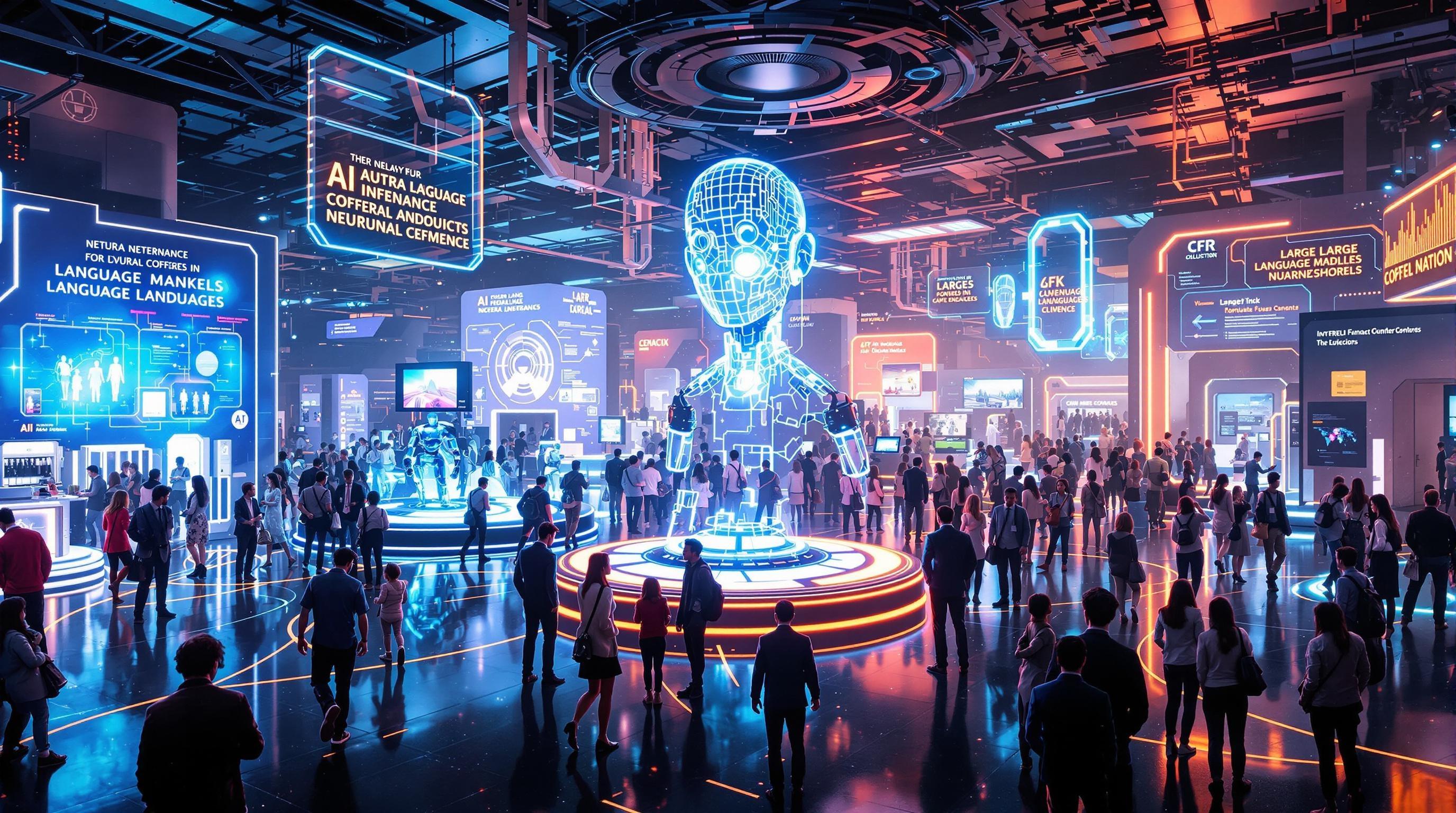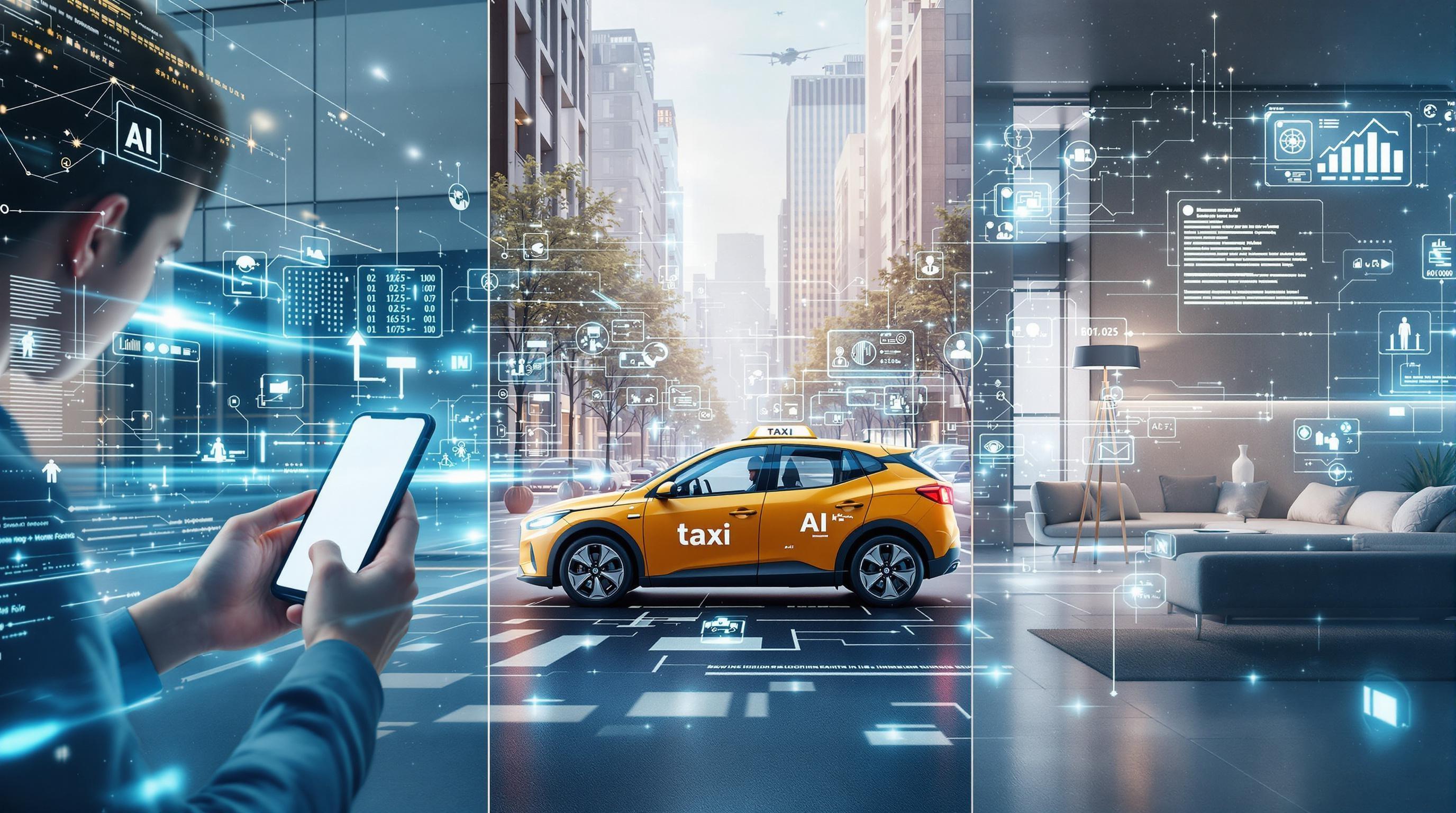AI in 2025: WAIC, Samsung's AI Partnerships, Google's AI Growth, and the Future of AI Ethics

Stay ahead of the curve in the rapidly evolving AI landscape by understanding key strategic trends, ethical considerations, and policy implications discussed in recent AI summits and industry analyses. Discover how multipolar alliances, the infra-scale arms race, and front-loaded governance are shaping AI's future, and learn how to diversify AI dependencies to protect your business from disruption. For actionable insight, explore AI literacy to ensure you can harness the transformative power of AI.
Chinese AI Takes Center Stage at Shanghai’s WAIC 2025
The global AI landscape is constantly shifting, and all eyes are on Shanghai as it prepares to host the World AI Conference (WAIC) 2025. This event promises to be a pivotal moment, showcasing China's growing influence and ambition in the field of artificial intelligence.

China's AI Ambition on Display
Despite facing significant headwinds from U.S. export controls, China remains steadfast in its goal to become a global leader in AI technology. WAIC 2025 will serve as a powerful platform to demonstrate this resolve, highlighting the nation's progress in developing cutting-edge AI solutions and fostering a vibrant domestic AI ecosystem. The conference is expected to draw significant international attention, offering a glimpse into China's unique approach to AI development.
China's commitment to AI leadership is unwavering, even amidst international challenges.
Domestic Innovation Takes Center Stage
A key theme of WAIC 2025 will be the emphasis on domestic innovation. Chinese companies are increasingly focused on developing their own AI chips and AI models, reducing reliance on foreign technology. This push for self-sufficiency is driven by both strategic considerations and the desire to create AI solutions tailored to the specific needs of the Chinese market. Expect to see showcases of:
Novel AI chips: Designed and manufactured in China, optimized for AI workloads.
Advanced AI models: Developed by Chinese research institutions and tech companies, with a focus on natural language processing, computer vision, and other key AI capabilities.
Applications across industries: Demonstrations of how these technologies are being applied in areas such as manufacturing, healthcare, finance, and transportation.
WAIC: A Hub for Collaboration and Competition
Beyond showcasing domestic achievements, WAIC also aims to promote international collaboration in AI. The conference will bring together researchers, entrepreneurs, policymakers, and investors from around the world, fostering discussions and partnerships that can accelerate AI innovation globally. However, it's also a space for competition, with different nations and companies vying for leadership in various AI domains. You can learn more about global trends in the AI News section of our site. The spirit of both cooperation and rivalry is anticipated to fuel dynamic exchanges and breakthroughs.
AI Sovereignty and Data Localization
WAIC 2025 will likely underscore the importance of AI sovereignty and data localization. China has implemented strict regulations regarding the collection, storage, and use of data, reflecting its commitment to maintaining control over its digital infrastructure and protecting national interests. This emphasis on AI sovereignty may influence the types of collaborations and partnerships that are pursued, with a focus on ensuring that data remains within China's borders and under its jurisdiction. The push towards data control reflects a global trend of nations seeking to secure their digital assets and capabilities.
As WAIC 2025 approaches, the world is keen to see how China will leverage this platform to solidify its position in the global AI landscape and shape the future of this transformative technology. The discussions and showcases at WAIC are sure to have implications that extend far beyond Shanghai, influencing the direction of AI research, development, and deployment worldwide. This focus on China's AI advancements naturally leads to a broader look at how other major players are shaping the AI landscape, including Samsung and Google.
Samsung Seeks to Loosen Google’s Grip on Mobile AI with OpenAI and Perplexity AI Partnerships
Samsung is reportedly looking to shake up the mobile AI landscape, and their strategy involves forging partnerships with OpenAI and Perplexity AI, aiming to integrate AI agents into the upcoming Galaxy S26. Perplexity AI is a search engine that uses AI to provide answers to questions, rather than just a list of links.
Breaking Free from Google's Orbit
The core motivation behind these moves is clear: Samsung wants to lessen its dependence on Google's Google Gemini and gain a stronger hand when it comes to revenue sharing. Currently, Google's services are deeply embedded within Samsung's devices, which gives Google significant leverage. By bringing in alternatives like OpenAI and Perplexity AI, Samsung aims to create a more level playing field. This strategy isn't just about diversifying AI providers; it's about Samsung asserting its position in the value chain. Think of it like a homeowner getting multiple quotes for a renovation – more options mean more bargaining power.
Giving Consumers the AI Choice
One of the most exciting aspects of this strategy is the potential for consumer choice. Imagine a future where you can select your preferred AI-powered search and answer engine directly on your Samsung phone. Rather than being locked into Google's ecosystem, users might be able to choose between Gemini, Perplexity AI, or even other emerging AI agents. This is a win for consumers, who would have the power to tailor their AI experience to their specific needs and preferences. Some users may prefer Perplexity's concise, sourced answers, while others might favor the broader capabilities of a ChatGPT-like interface.
Optimizing for AI Performance
Samsung isn't just thinking about software; they're also strategically considering hardware to maximize AI performance. The company is reportedly evaluating both Qualcomm chips and their own Exynos 2600 chips with the goal of optimizing AI processing on the Galaxy S26. This focus on hardware highlights the growing importance of specialized AI accelerators in mobile devices. Just as gaming laptops need powerful GPUs, smartphones of the future will need dedicated AI chips to handle increasingly complex AI tasks. This competition extends to chipmakers like Nvidia AI Workbench.
The Mobile AI Arena: Competition and Bargaining
Samsung's moves are indicative of a larger trend in the mobile AI space: increased competition and platform bargaining. As AI becomes more integral to the mobile experience, device manufacturers are keen to avoid being overly reliant on any single AI provider. This creates a dynamic environment where AI companies must compete to offer the best performance, features, and revenue-sharing terms to secure partnerships with major device manufacturers. It's a high-stakes game of chess where the ultimate goal is to control the AI experience on billions of mobile devices worldwide. The stakes are high, and as AI News constantly reports, the players are constantly shifting their strategies. Ultimately, this competition should lead to more innovative and user-friendly AI experiences for consumers.

Google’s AI Overviews Surge Past 2 Billion Users: Strategic Risks and Opportunities
Google's AI ambitions are clearly resonating with a massive audience, but this rapid expansion comes with both exciting opportunities and considerable risks. Let's break down the latest developments.
Exponential Growth in AI Overview Usage
The numbers are staggering: Google's AI Overviews have surged in popularity, now reaching over 2 billion monthly users. That's a massive adoption rate, indicating that people are increasingly turning to AI-powered summaries to get quick answers and information. This demonstrates the shift in user behavior and highlights the convenience that AI brings to everyday information seeking. It also shows the power of AI tools for search.
Two billion users is not just a number; it's a signal that AI is becoming deeply integrated into how we access information.
Gemini App's Rising Popularity
It's not just AI Overviews that are seeing gains. The Google Gemini app, Google's flagship AI model designed to be a versatile assistant, is also experiencing significant growth. Daily queries have jumped by 50%, signaling a growing user base that's actively engaging with Gemini for various tasks. Whether it's brainstorming ideas, drafting emails, or answering complex questions, Gemini is becoming an indispensable tool for many. To harness the power of such tools, many are turning to Prompt Engineering to unlock better results.
Massive Token Processing
Behind the scenes, Google is processing an enormous amount of data to power these AI experiences. The company has reported a doubling in token processing since May, highlighting the scale of computational resources being dedicated to AI. This reflects the increasing complexity of AI models and the growing demand for AI-driven services. To put it in perspective, imagine reading every book in the Library of Congress multiple times over – that’s the scale we're talking about!
Declining Click-Through Rates: A Publisher's Dilemma
However, this growth isn't without its challenges. One of the most pressing concerns is the decline in click-through rates (CTR) for publishers. As AI Overviews provide more comprehensive summaries directly in the search results, users have less incentive to click through to the original sources. For publishers who rely on ad revenue generated from website traffic, this can have a significant impact. The shift calls for strategic adjustments, like focusing on original reporting, niche expertise, and engaging content that AI can't easily replicate. Many now leverage AI News aggregators to keep ahead of the curve.
Capital Expenditure and Investor Confidence
Another challenge lies in the high capital expenditure required to support Google's AI initiatives. Building and maintaining massive data centers to power AI models is an expensive undertaking. This substantial investment has raised concerns among some investors, who are carefully watching to see if the returns justify the costs. It's a delicate balancing act: Google needs to invest heavily to stay ahead in the AI race, but it also needs to demonstrate that these investments are paying off in terms of revenue and profitability.
The future of Google's AI strategy hinges on its ability to balance innovation with financial prudence.
Google's AI journey is at a pivotal moment. The company is making significant strides in AI adoption, but it must also address the challenges of declining click-through rates and high capital expenditure. Navigating these complexities will be crucial for Google to solidify its position as a leader in the AI era. As AI continues to evolve, monitoring developments in AI Fundamentals will prove valuable.

Pony.ai Launches 24/7 Robotaxi Service: A Milestone in Autonomous Driving
Imagine hopping into a taxi at 3 AM, knowing there's no human driver, just a sophisticated AI ready to whisk you away safely. That future is rapidly becoming our present, thanks to companies like Pony.ai.
Pony.ai's 24/7 Robotaxi Revolution
Pony.ai has achieved a significant milestone in the autonomous driving industry by launching a 24/7 robotaxi service in the bustling metropolises of Guangzhou and Shenzhen. This isn't just a minor upgrade; it's a full-fledged, round-the-clock operation that signals a new era in transportation. For residents and visitors alike, this means access to on-demand, driverless transportation at any hour, offering unprecedented convenience and potentially reshaping urban mobility patterns.
The service leverages a fleet of autonomous vehicles equipped with advanced sensor suites and sophisticated AI algorithms. These vehicles navigate complex urban environments, responding dynamically to traffic conditions, pedestrian movements, and unexpected obstacles. What sets Pony.ai apart is their commitment to pushing the boundaries of what's possible, continually refining their technology to ensure safety and reliability.
Expanding Autonomous Horizons in Beijing
Pony.ai's ambitions don't stop at Guangzhou and Shenzhen. The company is also making strides in Beijing, with a significant expansion of autonomous vehicle testing hours. This increased testing window allows Pony.ai to gather more data, fine-tune its algorithms, and expose its vehicles to a wider range of real-world scenarios. Think of it as an AI boot camp, where the vehicles learn to handle everything from rush-hour traffic to unexpected weather conditions.
The move to expand testing hours in Beijing is strategically important. Beijing's unique regulatory environment and complex traffic patterns provide a challenging but crucial testing ground for autonomous driving technology. By successfully navigating Beijing's roads, Pony.ai is demonstrating the robustness and adaptability of its technology, paving the way for broader deployment in other cities.
50 Million Kilometers: A Testament to Experience
One of the most compelling indicators of Pony.ai's progress is the sheer volume of real-world testing it has conducted. To date, the company has accumulated 50 million kilometers of global autonomous test mileage. That's like driving around the Earth 1,250 times! This massive dataset provides invaluable insights into the performance of Pony.ai's autonomous driving system, allowing engineers to identify and address potential weaknesses, optimize algorithms, and improve overall safety.
This extensive testing not only validates the technology but also builds trust with regulators and the public. The more miles driven, the more confidence stakeholders have in the safety and reliability of autonomous vehicles.
Safety First: Ten Times Better Than Humans
Safety is paramount in the development and deployment of autonomous driving technology. Pony.ai emphasizes this point, claiming that its systems achieve safety levels ten times better than human drivers. While such claims require careful scrutiny and independent verification, they highlight the potential of AI to significantly reduce traffic accidents and improve road safety.
This impressive safety record is attributed to the rigorous testing, continuous algorithm refinement, and redundant safety systems incorporated into Pony.ai's autonomous vehicles. Unlike human drivers who can be distracted, fatigued, or impaired, AI-powered systems are always alert, processing data with unwavering precision. While perfection is unattainable, the goal is to create a system that consistently outperforms human drivers in terms of safety and reliability.
The Importance of Night-Time Service
Operating a 24/7 robotaxi service isn't just about convenience; it's also about pushing the limits of the technology. Night-time service is particularly important for stress-testing sensor technology. Darkness, reduced visibility, and the presence of unexpected obstacles create a challenging environment for autonomous vehicles.
By operating at night, Pony.ai can gather critical data on how its sensors and algorithms perform under adverse conditions. This data is then used to further refine the system, improving its ability to navigate safely and reliably in all environments.
The night-time service acts as a proving ground, ensuring that the technology is robust enough to handle the unpredictable challenges of real-world driving, regardless of the time of day. As the AI field advances, it is important to stay abreast of the latest AI News to see how safety is improved.
Pony.ai's achievements represent a significant leap forward in the development and deployment of autonomous driving technology. By launching a 24/7 robotaxi service, expanding testing hours, accumulating vast amounts of test mileage, and prioritizing safety, the company is paving the way for a future where autonomous vehicles are an integral part of our transportation ecosystem. As these technologies mature, we can expect even more innovation and disruption in the years to come. Next, we'll examine Samsung's strategic AI partnerships and what they signify for the tech giant's future.

AI DevOps Market to Add USD 8.61 Billion by 2029: Key Trends and Drivers
Imagine a world where AI development is as streamlined and efficient as a perfectly tuned engine. That future is rapidly approaching, and the AI DevOps market is poised for explosive growth.
The Rise of AI DevOps
According to recent analysis, the AI DevOps market is projected to add a staggering USD 8.61 billion by 2029. This monumental growth underscores the increasing importance of efficient development and deployment pipelines in the age of AI. The forecast highlights not just a trend, but a fundamental shift in how AI solutions are built, managed, and scaled. AI DevOps facilitates streamlined workflows, faster release cycles, and improved collaboration between data scientists, developers, and operations teams. It's about bringing the best practices of DevOps to the unique challenges of AI.
Generative AI as a Key Driver
One of the primary catalysts behind this surge is the widespread adoption of generative AI. With an anticipated Compound Annual Growth Rate (CAGR) of 26.6%, the AI DevOps market is directly benefiting from the generative AI revolution. Generative AI models, like those that power Sora or Runway, demand robust infrastructure and continuous integration/continuous deployment (CI/CD) pipelines to handle their complexity. This includes:
Model Training: Streamlining the training process with automated data preparation and hyperparameter tuning.
Model Deployment: Ensuring smooth deployment and scaling of models in production environments.
Model Monitoring: Continuously monitoring model performance and detecting anomalies.
Generative AI's insatiable need for efficient DevOps practices is fueling the market's rapid expansion.
AIOps Platforms: Convergence of Key Metrics
As AI systems become more intricate, the need for unified management solutions grows. AIOps (Artificial Intelligence for IT Operations) platforms are evolving to meet this demand by converging security, observability, and cost metrics. These platforms leverage AI and machine learning to automate IT operations, providing real-time insights and proactive problem-solving. For instance, they can:
Predict potential security threats based on anomaly detection.
Optimize resource allocation to reduce cloud costs.
Provide end-to-end visibility into AI application performance.
By integrating these critical metrics into a single pane of glass, AIOps platforms empower organizations to manage their AI infrastructure more effectively and efficiently. This trend towards convergence is essential for maintaining the health, security, and cost-effectiveness of AI deployments.
Shift-Left Security and Automated Compliance
In the ever-evolving threat landscape, security cannot be an afterthought. The growing emphasis on shift-left security is driving the adoption of AI-powered DevOps practices that integrate security earlier in the development lifecycle. This includes:
Automated Vulnerability Scanning: Identifying and addressing security vulnerabilities in code and infrastructure.
Compliance as Code: Automating compliance checks and ensuring adherence to regulatory requirements.
Continuous Security Monitoring: Monitoring AI systems for suspicious activity and proactively mitigating threats.
By embedding security into the DevOps pipeline, organizations can reduce the risk of security breaches and ensure the integrity of their AI applications. Automated compliance checks further streamline the process, minimizing the burden on developers and ensuring consistent adherence to industry standards.
The High Demand for AI/ML Skills
The AI DevOps revolution is creating a surge in demand for developers with specialized AI and machine learning (ML) skills. Companies are actively seeking professionals who can bridge the gap between AI development and IT operations. These skills include:
Proficiency in AI/ML frameworks such as TensorFlow and PyTorch.
Experience with DevOps tools and practices, such as CI/CD, containerization, and infrastructure as code.
Strong understanding of data science principles and machine learning algorithms.
To meet this demand, many developers are turning to resources like the AI Explorer on best-ai-tools.org to learn and grow their skillset.
The growing demand for these specialized skills is driving up salaries and intensifying competition for talent. Organizations that invest in training and upskilling their workforce will be best positioned to capitalize on the opportunities presented by the AI DevOps market.
As we look ahead, the AI DevOps market promises to be a hotbed of innovation and growth. The convergence of security, observability, and cost metrics, along with the emphasis on shift-left security and automated compliance, will drive further advancements in the field. The demand for developers with AI/ML skills will continue to rise, shaping the future of AI development and deployment. Staying ahead of these trends is crucial for organizations seeking to harness the power of AI and gain a competitive edge. You can stay up to date with AI News on best-ai-tools.org.

Singapore Brainstorm AI Summit Urges “Humane” AI Development: Prioritizing Ethics and Governance
The world is watching as AI's capabilities expand at breakneck speed, and the recent Fortune Brainstorm AI Summit in Singapore served as a critical gathering to discuss the responsible path forward, focusing specifically on how to maintain a "humane" approach to AI development.
Prioritizing Ethics in the Age of AI
The Fortune Brainstorm AI Summit wasn't just another tech conference filled with demos and product announcements. It was a crucial discussion about the ethical implications of AI and how to ensure its development aligns with human values. The conversations revolved around the need for a proactive approach to AI ethics, rather than simply reacting to problems as they arise. Speakers emphasized that ethical considerations should be embedded into every stage of AI development, from the initial design to deployment and ongoing monitoring. This involves considering potential biases in algorithms, ensuring transparency in AI decision-making processes, and safeguarding user privacy.
A Multi-Stakeholder Approach to AI Governance
A central theme of the summit was the call for a multi-stakeholder approach to AI governance. The overwhelming consensus was that the responsibility for AI ethics shouldn't rest solely with tech companies. The concern is that leaving it to tech companies alone could lead to a narrow focus, potentially overlooking broader societal impacts and ethical considerations. The summit highlighted the necessity of involving diverse voices, including policymakers, academics, civil society organizations, and the public, in shaping the ethical framework for AI. This inclusive approach aims to ensure a more comprehensive and balanced perspective, reflecting a wider range of values and concerns.
A key takeaway was that effective AI governance requires collaboration and open dialogue among all stakeholders to prevent a future where AI ethics are solely determined by the priorities of the tech industry.
Global Alignment on Ethical AI Frameworks
The discussions in Singapore resonate strongly with ongoing global efforts to establish ethical AI guidelines and regulations. The summit acknowledged the importance of aligning with initiatives like the EU AI Act, which sets strict rules for AI systems based on risk levels, and UNESCO's recommendations on the ethics of AI, which promote human rights and dignity. Furthermore, the summit participants explored how different regions and countries can collaborate to create a unified global framework for AI ethics, promoting consistency and preventing a fragmented regulatory landscape. The goal is to establish a shared understanding of ethical principles and standards, fostering responsible AI innovation worldwide. You can stay abreast of these developments by following AI News.
Embedding Societal Values into AI
The summit underscored the importance of embedding societal values into AI development. This involves proactively identifying and addressing potential biases in AI algorithms, ensuring fairness and equity in AI decision-making, and promoting transparency and accountability in AI systems. Speakers shared concrete examples of how to incorporate ethical considerations into the technical design of AI, such as using diverse datasets to train models and implementing explainable AI techniques to understand how AI arrives at its decisions. Ultimately, the goal is to build AI systems that not only are technologically advanced but also reflect and uphold the values of the societies they serve. One way to explore and understand these concepts further is through AI Explorer.
The Singapore Brainstorm AI Summit was a clear signal that the future of AI hinges not only on technological advancements but also on our collective commitment to ethical development and responsible governance. The call for a multi-stakeholder approach and alignment with global standards is crucial to ensuring AI benefits all of humanity. As AI continues to permeate every aspect of our lives, these discussions will only become more critical.
Five Strategic Trends Shaping AI Today: From Multipolar Alliances to Ethical Governance
The AI landscape is no longer a simple race; it's a complex game of alliances, infrastructure, and ethics. As we navigate 2025, several strategic trends are crystallizing, shaping the direction of AI and its impact on society. Let's delve into these key shifts.
The Rise of Multipolar AI Alliances
Gone are the days when AI dominance was solely a US-China binary. We're witnessing the emergence of multipolar AI alliances, where diverse players collaborate and compete in unique ways. This trend is exemplified by Samsung's vendor-agnostic approach. Instead of relying solely on one AI provider, they strategically partner with multiple companies to leverage the best solutions for specific applications. Think of it as building a dream team for AI, pulling in talent from various specialized areas.
Another compelling example is China's WAIC (World Artificial Intelligence Conference) diplomacy. WAIC isn't just a tech conference; it's a platform for fostering international collaborations and showcasing China's AI prowess. It's a strategic move to build relationships, share knowledge, and establish China as a key player in the global AI ecosystem. This kind of 'AI diplomacy' suggests a future where nations cooperate – and perhaps compete – on AI standards, ethics, and development, rather than just technology.
This multipolar world offers the potential for more diverse and resilient AI ecosystems, preventing any single entity from monopolizing the technology and its benefits.
The Infra-Scale Arms Race
Underneath the surface of dazzling AI applications lies a fierce infra-scale arms race. AI's insatiable appetite for data and processing power is driving massive investments in data centers and sensor technology. Imagine the internet as a vast ocean; now picture AI as a fleet of ships constantly searching for resources. These resources are data, and the ships need bigger engines (data centers) and better navigation tools (sensors) to compete.
The demand for increasingly sophisticated sensors is exploding. From high-resolution cameras for autonomous vehicles to advanced medical imaging devices, the ability to gather and interpret data is crucial for AI's continued progress. This arms race isn't just about hardware; it's also about the software and algorithms that can efficiently manage and process this deluge of information. Companies are racing to develop cutting-edge solutions for data storage, transfer, and analysis, ensuring they can keep pace with AI's ever-growing demands. You can see this trend reflected in the AI News reporting.
Fragmented Consumer Experience
The proliferation of AI agents is creating a double-edged sword for consumers. On one hand, we have access to more personalized and intelligent services than ever before. Need a restaurant recommendation? An AI agent can provide curated suggestions based on your preferences. Want help writing an email? Tools like Hubspot Email Writer are ready to assist.
However, this abundance of AI agents is also leading to a fragmented consumer experience. Each agent operates within its own silo, often with limited integration with other services. Imagine having to juggle multiple apps and interfaces just to complete a simple task. This fragmentation can be overwhelming and inefficient, making it difficult for consumers to fully realize the benefits of AI. The challenge lies in creating a more seamless and unified experience, where AI agents can work together harmoniously to anticipate and fulfill our needs. To create seamless interactions, you need excellent Prompt Engineering.
Automation of the SDLC: Generative AI Transforming DevOps
Generative AI is no longer just about creating art or writing content; it's revolutionizing the software development lifecycle (SDLC). The automation of the SDLC is advancing at an astonishing pace, with generative AI transforming DevOps practices. Tasks that once required countless hours of manual effort can now be automated with remarkable speed and accuracy. Tools like Github Copilot, an AI pair programmer, are becoming indispensable for developers, helping them write code faster, debug more efficiently, and explore new design possibilities.
From automatically generating code snippets to creating test cases and even deploying applications, generative AI is streamlining every stage of the SDLC. This not only accelerates the development process but also frees up developers to focus on more creative and strategic tasks. The result is faster innovation, higher-quality software, and reduced development costs. The speed and reliability improvements are a game changer for the entire industry.
Front-Loaded Governance and Ethics
As AI becomes more pervasive, concerns about its potential impact on society are growing. This is driving a critical trend: front-loaded governance and ethics in AI development. Companies and organizations are recognizing the importance of embedding ethical considerations into the design and deployment of AI systems from the very beginning.
This includes developing frameworks for responsible AI, addressing bias in algorithms, ensuring transparency and accountability, and safeguarding privacy. It's about proactively identifying and mitigating potential risks before they materialize. This front-loaded approach to ethics and governance is not just a matter of compliance; it's a strategic imperative. By building trust and ensuring that AI is used responsibly, organizations can unlock its full potential while minimizing the potential for harm. To learn more about this, check out the AI Glossary.
These five strategic trends – multipolar alliances, the infra-scale arms race, fragmented consumer experience, SDLC automation, and front-loaded governance – are not isolated phenomena. They are interconnected forces shaping the future of AI in profound ways. Navigating this complex landscape requires a holistic approach, one that embraces collaboration, innovation, and a deep commitment to ethical principles. Only then can we harness the transformative power of AI for the benefit of all.
Implications of AI Advancements for Policy, Business, and Society
The relentless march of artificial intelligence isn't just a technological phenomenon; it's a societal earthquake, reshaping the landscape of policy, business, and everyday life. As we stand on the cusp of 2026, the implications of these advancements demand careful consideration and proactive strategies from all stakeholders. Let's break down the key areas where AI's impact will be most profound.
Harmonizing AI Safety Standards
Policymakers face the urgent task of creating a unified framework for AI safety. This isn't just about abstract principles; it's about concrete regulations that protect citizens and promote responsible innovation. Imagine a world where autonomous vehicles from different manufacturers operate under conflicting safety protocols, or where AI-driven medical diagnoses are held to different standards of accuracy. The result would be chaos and eroded public trust.
To prevent such scenarios, governments worldwide must collaborate to:
Establish common definitions and benchmarks: What exactly constitutes "safe" AI? What metrics should be used to evaluate AI systems? These questions need clear, internationally recognized answers.
Develop risk-based regulatory approaches: AI applications vary widely in their potential impact. A high-stakes field like healthcare requires stricter oversight than, say, an AI-powered photo editing app. Like Adobe Photoshop AI.
Promote transparency and accountability: Developers should be required to document their AI systems' design, training data, and decision-making processes. This would allow for independent audits and facilitate the identification of potential biases or vulnerabilities. You can learn more about the ethical considerations of AI from our AI News section.
The goal isn't to stifle innovation but to guide it in a direction that benefits all of humanity. Standardizing AI safety is not just an option, it's a necessity.
Diversifying AI Dependencies in Enterprises
For businesses, the AI revolution presents both immense opportunities and potential pitfalls. One of the biggest risks is over-reliance on a single AI provider or platform. Putting all your eggs in one basket can leave you vulnerable to price hikes, service disruptions, or even the strategic whims of a competitor.
To mitigate this risk, enterprises should:
Adopt a multi-vendor approach: Explore and integrate AI solutions from different providers. This not only reduces dependency but also allows you to leverage the unique strengths of each platform. For instance, you might use Google Cloud AI for its robust infrastructure and Salesforce Platform for its CRM-integrated AI capabilities.
Invest in in-house AI expertise: Building a team of AI specialists allows you to customize AI solutions to your specific needs and reduces your reliance on external consultants. It also ensures you have the knowledge to evaluate and integrate new AI technologies as they emerge.
Embrace open-source AI tools: Open-source frameworks like TensorFlow and PyTorch offer flexibility, transparency, and community support. They allow you to build and deploy AI models without being locked into a proprietary ecosystem.
Assessing Monetization Potential of Consumer AI
The consumer AI market is booming, with new AI-powered apps and services popping up every day. But not all of these ventures are created equal. Investors need to be discerning, carefully evaluating the long-term monetization potential of consumer AI products.
Here are some key questions to ask:
Does the product solve a real problem? Is there a genuine need for the AI-powered solution, or is it just a novelty? Many AI tools are available; for example, you could use Runway for video editing.
Is the value proposition clear? Can users easily understand the benefits of using the AI product? A confusing or convoluted value proposition will deter adoption.
Is the business model sustainable? Will users be willing to pay for the AI service in the long run? Subscription models, freemium offerings, and targeted advertising are all potential revenue streams, but each has its own challenges.
Is the AI defensible? Can the AI technology be easily replicated by competitors? Unique datasets, proprietary algorithms, and strong brand recognition can provide a competitive edge.
Engaging Civil Society for Fairness, Privacy, and Transparency
AI's potential to exacerbate existing inequalities is a serious concern. AI systems can perpetuate biases present in their training data, leading to discriminatory outcomes in areas like hiring, lending, and criminal justice. Moreover, the increasing use of AI raises profound questions about privacy, autonomy, and the potential for manipulation.
To address these challenges, civil society organizations must play an active role in shaping the future of AI by:
Advocating for ethical AI principles: Civil society can push for the adoption of AI ethics guidelines that prioritize fairness, privacy, transparency, and accountability.
Monitoring AI systems for bias and discrimination: Independent audits and investigations can help identify and mitigate discriminatory outcomes.
Educating the public about AI's potential risks and benefits: Informed citizens are better equipped to make decisions about how AI is used in their communities. Resources like our Learn section can help.
Rapid Upskilling in AI Technologies for Workforce Development
The AI revolution will create new jobs, but it will also displace many existing ones. To ensure a smooth transition, workforce development programs must prioritize rapid upskilling in AI technologies. This isn't just about training AI engineers; it's about equipping workers across all industries with the skills they need to collaborate with AI systems.
Key areas of focus should include:
AI literacy: Everyone needs a basic understanding of what AI is, how it works, and its potential applications. Explore AI Fundamentals to improve your AI literacy.
Data analysis: The ability to collect, analyze, and interpret data is becoming increasingly valuable in an AI-driven world.
Prompt engineering: As AI becomes more conversational, the ability to effectively communicate with AI systems will be essential. Master Prompt Engineering to make the most of AI's capabilities.
Ethical AI development and deployment: Workers need to be aware of the ethical implications of AI and how to develop and deploy AI systems responsibly.
By proactively addressing these policy, business, and societal implications, we can harness the transformative power of AI while mitigating its risks and ensuring a future where AI benefits all of humanity. Understanding the ethical considerations and societal changes is a continuous process, and staying informed through resources like AI News is crucial for navigating this evolving landscape.
🎧 Listen to the Podcast
Hear us discuss this topic in more detail on our latest podcast episode: https://creators.spotify.com/pod/profile/bestaitools/episodes/Global-AI-Press-Review--July-25--2025-WAIC-Samsung-Google-AI-Pony-Singapore-e360hdv
Keywords: AI, Artificial Intelligence, WAIC 2025, Samsung AI, Google AI Overviews, Pony.ai Robotaxi, AI DevOps, Humane AI, Chinese AI, Mobile AI, AI Ethics, AI Trends, AI Governance, AI Development, Global AI
Hashtags: #AI #ArtificialIntelligence #TechNews #Innovation #FutureofAI
For more AI insights and tool reviews, visit our website https://best-ai-tools.org, and follow us on our social media channels!
Website: https://best-ai-tools.org
X (Twitter): https://x.com/bitautor36935
Instagram: https://www.instagram.com/bestaitoolsorg
Telegram: https://t.me/BestAIToolsCommunity
Medium: https://medium.com/@bitautor.de
Spotify: https://creators.spotify.com/pod/profile/bestaitools
Facebook: https://www.facebook.com/profile.php?id=61577063078524
Recommended AI tools
Databricks
Data Analytics
Bring AI to your data. Bring AI to the world.
Snowflake (AI Data Cloud)
Data Analytics
Your Data. Your AI. One Cloud.
Weights & Biases
Data Analytics
The AI Developer Platform
Fusion Brain
Image Generation
Empowering AI for Everyone
Rize
Writing & Translation
Empowering content creators with AI
Secoda
Data Analytics
The AI-powered data co-pilot for analytics, discovery, and governance


